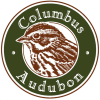After an unusual spring with what seemed like a lot of premature appearances by migrant birds statewide, we overlooked recent mildly interesting reports of winter’s birds elsewhere to encounter the utmost front of spring’s arrival. A trip to Shawnee State Forest is a treat we usually—and will again this year—reserve for greeting the full-throttle advance of neotropical migrants headed north during lat April, but we thought that in this precocious year we might find some interesting birds, and so we did.
We started well before dark, mostly to get to the Forest early, but of course stopped for birds along the way. Woodcocks weren’t found, but we found short-eared owls barking at twilight as they went to their day roost near Charlie’s Pond. Thirteen of us convened at the marina along the Ohio River, and went immediately to the Forest looming above. On a cool, dim, and breezy day, we found birds much easier to find in the low elevations. Early on, a ruffed grouse provided a back-beat to discoveries of our first early migrants, and it became quite clear that sapsuckers were to be our most frequently-found woodpecker. We found the first warblers, yellow-throated and yellow-rumped, Louisiana waterthrush, and pine, and a squabbling pair of male black-and-whites that rivaled Ohio’s earliest records of this species. Raptors and turkey vultures were seldom seen in the gloomy sky. Both kinglets were found, as well as purple and house finches, but we felt more species may have been found had clear skies and the predicted 60+ temperatures come to pass.
Our stops on the way back included Lake White and a diurnal visit to Charlie’s Pond. At the lake, we added some commoner waterfowl species to our list, and with spotting scopes were able to identify some new swallows and swifts, along with our only gulls of the day, two Bonaparte’s. At the Pond we had several sparrow species, harriers among other raptors, snipes, and a nice talk with the local farmer, who recalled with some chagrin the hordes who occupied his flooded swale when we discovered a black rail there a few years back; we were able to laugh about it, and he good-naturedly admitted that well-behaved folks with binoculars roaming the area were better than most of the usual visitors.
Our day’s total of 73 species was OK for the date, and included some nice finds. Overall, our discoveries did not confirm a flood of unusually early migrants this spring, but rather the expected schedule. Here is our list:
Canada goose
Wood duck
American black duck
Mallard
Blue-winged teal
Green-wnged teal
Ring-necked duck
Hooded merganser
Ruddy duck
Ring-necked pheasant
Ruffed grouse
Pied-billed grebe
Horned grebe
Double-crested cormorant
Great blue heron
Turkey vulture
Northern harrier
Cooper’s hawk
Red-tailed hawk
American kestrel
American coot
Killdeer
Wilson’s snipe
Bonparte’s gull
Rock pigeon
Mourning dove
Short-eared owl
Chimney swift
Red-bellied woodpecker
Downy woodpecker
Hairy woodpecker
Pileated woodpecker
Eastern phoebe
Blue jay
American crow
Horned lark
Tree swallow
Northern rough-winged swallow
Cliff swallow
Carolina chickadee
Tufted titmouse
White-breasted nuthatch
Brown creeper
Carolina wren
Golden-crowned kinglet
Ruby-crowned kinglet
Eastern bluebird
American robin
Northern mockingird
Brown thrasher
European starling
Yellow-rumped warbler
Yellow-throated warbler
Pine warbler
Black-and-white warbler
Louisiana waterthrush
Eastern towhee
American tree sparrow
Chipping sparrow
Field sparrow
Savannah sparrow
Song sparrow
White-crowned sparrow
Dark-eyed junco
Northern cardinal
Red-winged blackbird
Eastern meadowlark
Common grackle
Brown–headed cowbird
Purple finch
House finch
American goldfinch
House sparrow
